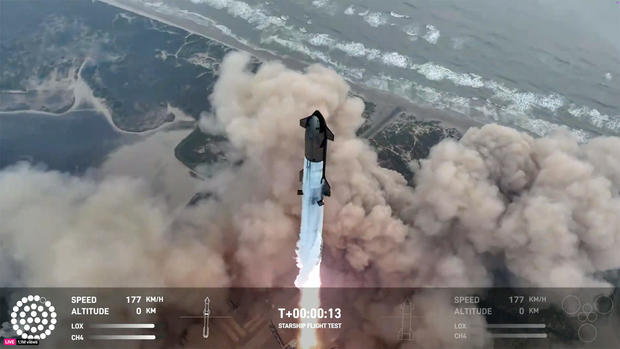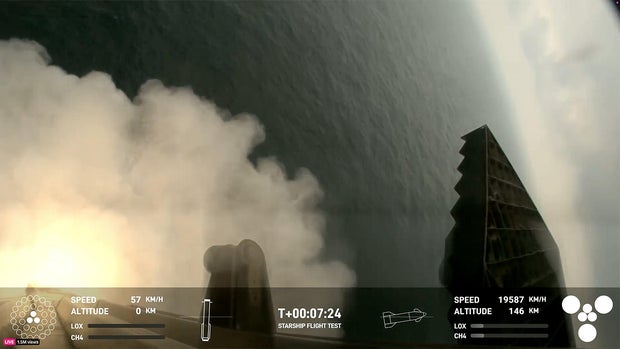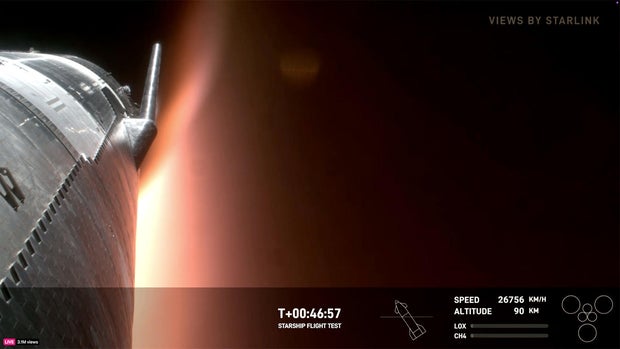SpaceX's Super Heavy-Starship rocket launches on "epic" test flight
SpaceX launched the world's most powerful rocket on its fourth flight Thursday, successfully putting the company's Starship upper stage into space and then bringing it back down through the heat of re-entry for an apparently controlled splashdown in the Indian Ocean despite severe damage to at least one steering fin.
The gargantuan Super Heavy first stage booster also pulled off a controlled descent to a "soft" landing in the Gulf of Mexico after propelling the Starship out of the lower atmosphere. It was the first time both stages were able to accomplish the test flight's primary objectives.
"Despite loss of many (heat-shield) tiles and a damaged flap, Starship made it all the way to a soft landing in the ocean!" SpaceX founder Elon Musk said on X. "Congratulations @SpaceX team on an epic achievement!"
The 397-foot-tall rocket blasted off from SpaceX's Boca Chica, Texas, "Starbase" flight facility at 8:50 a.m. EDT, thundering away from the Gulf Coast on the power of 33 methane-burning Raptor engines in the Super Heavy first stage.
With Musk looking on from the company's launch control center, holding one of his children on his lap, the Super Heavy-Starship climbed from its pad atop a brilliant jet of flaming exhaust, arcing to the east as it accelerated skyward.
Capable of generating 16 million pounds of thrust during the initial stages of flight, the rocket is by far the most powerful launcher ever built with more than twice the liftoff thrust of the space shuttle, NASA's legendary Apollo program Saturn 5 and the Space Launch System rocket designed for the agency's Artemis moon rocket.
Despite one Raptor shutting down early, the Super Heavy propelled the Starship upper stage out of the dense lower atmosphere then separated, flipped around and restarted multiple engines to reverse course and head back toward the Gulf Coast. The Starship, meanwhile, powered by six Raptors of its own, continued the climb to space on its own.
In a first for the test program, the Super Heavy carried out a controlled descent, firing up three engines to slow down for splashdown amid waves of raucous cheers and applause in SpaceX's Hawthorne, California, factory as live television images showed the tail of the boosting splashing into the water.
The 160-foot-tall Starship, meanwhile, reached its planned sub-orbital trajectory as planned and then coasted around the world before falling back into the atmosphere. Live television views showed the rocket bathed in the red glow of atmospheric friction as it fell belly first back into the lower atmosphere.
During the rocket's third test flight in March, the Starship did not survive its encounter with atmospheric friction, breaking up at high altitude. This time around, the vehicle appeared rock steady as it plunged back to Earth, bathed in super-heated plasma that could be seen engulfing the belly and the rocket's steering fins.
As the descent continued, a camera showed the heat eating away a steering fin, with chunks of flaming debris ripping away.
"This is a nail-biter!" exclaimed SpaceX commentator Kate Tice.
Remarkably, data from the Starship continued flowing in and the vehicle's engines re-ignited for the planned landing burn. What orientation the ship was in when it hit the water could not be seen in views from an obviously damaged camera, but getting to that point marked a major success.
"It was incredible," said SpaceX spokesman Dan Huot. "I can't wait until the next one."
Both the Super Heavy booster and Starship are designed to be fully reusable. Once operational, SpaceX plans to fly the first stage back to the launch site where it will be captured by giant mechanical arms on its launch gantry. The Starship is designed to land at any available site, whether on Earth, the moon or even Mars.
But for the Super Heavy-Starship's initial test flights, recovery was not an option. The goal was to "simply" get both stages back to the lower atmosphere intact and under control.
"The fourth flight test turns our focus from achieving orbit to demonstrating the ability to return and reuse Starship and Super Heavy," SpaceX said on its website. "The primary objectives will be executing a landing burn and soft splashdown in the Gulf of Mexico with the Super Heavy booster, and achieving a controlled entry of Starship."
During three previous flights, two in 2023 and the most recent in March, the Super Heavy and Starship stages suffered catastrophic failures before all the test objectives could be met. But with each flight, SpaceX implemented hardware and software upgrades that resulted in dramatically improved performance.
In the third test flight, the Starship upper stage made it into space, looped around the planet and began a planned descent over the Indian Ocean before breaking up in the upper atmosphere. The Super Heavy booster made it back into the lower atmosphere over the Gulf of Mexico before control was lost.
But SpaceX hailed the flight as an overall success and made more changes to improve performance during Thursday's test.
Getting the Super Heavy-Starship flying on a regular basis is critical to NASA's Artemis moon program. NASA awarded SpaceX a $2.9 billion contract in 2021 to develop a variant of the Starship upper stage to carry astronauts from lunar orbit down to the surface and back. Artemis crews will travel to and from the moon using Lockheed Martin-built Orion capsules.
To reach the moon, multiple Super Heavy tanker flights will have to be launched to robotically refuel a Starship upper stage already in low-Earth orbit. The Starship lander then will fly itself to lunar orbit to await the Artemis moonwalkers.
NASA's contract requires one unpiloted lunar landing test flight before astronauts will make an actual landing attempt. Artemis managers are targeting late 2026 for the first lunar landing with astronauts on board.
But that will depend on SpaceX launching enough Super Heavy-Starship flights to demonstrate reliability. While SpaceX's philosophy is to fly frequently, learn from mistakes and fly again, NASA will require a long string of successful flights before the agency will deem it safe to put astronauts aboard.






